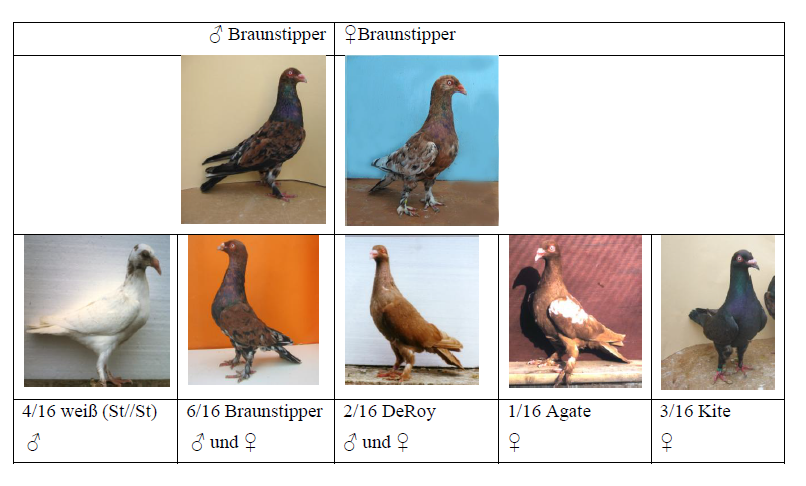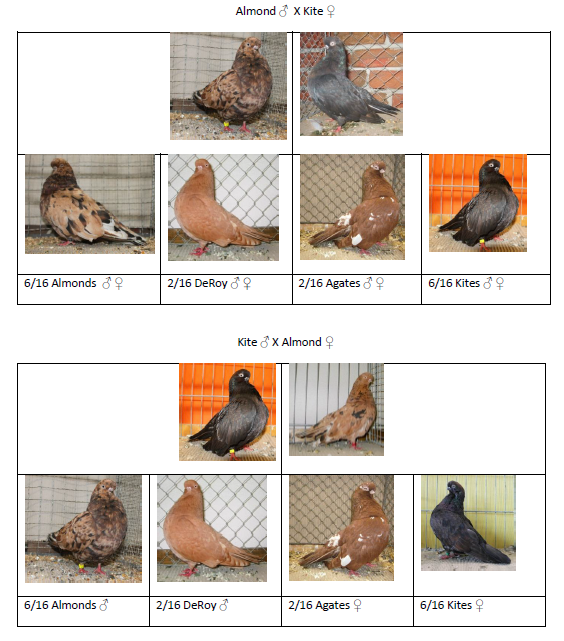|
Dänische Tümmler
Rules for Breeding Danish Stippers and Almonds in general
I got my first Danish Brown Stippers 1985 in Herning (Denmark) in exchange
for platinum Pomeranian Eye Crested Highfliers from the stock of Kr.
Schriver.
I soon realised that the main problem in breeding Almond – and the
Stippers carry the Almond or Stipple gene - is that homozygous almond
cocks lack vigor.
They are nearly white and often bladder-eyed as is shown below at a young
cock raised from the first imports.
Therefore, it is not possible to establish a pure strain of Almonds,
Stippers or Sprenkles. The so-called almond-related or complementary
colors should be used in the breeding pen. The term "Brown" Stipper is
misleading since the basic color of Brown Stippers is black as is in
classical Almonds.

Source: Axel Sell, Pigeon Genetics, Achim (Germany) 2012
In the following some general rules are given how to breed Almonds and how
to use the Almond-bred related colours. The rules are valid for breeding
the classical English Short Faced Almond Tumbler and for breeds with
similar requirements in the standards.
1.
Almond cock mated with a Kite, Gold Dun or Agate will produce about 50%
Almonds in both sexes. Some of the youngsters with the Almond trait may be
DeRoy.
2.
Almond hen mated with a Kite, Gold Dun or Agate cock will produce Almond
cocks and hens of the related colours.
3.
Two Almonds should not be matched since half of the young cocks are pure
Almonds, whitish, often bladder-eyed and of poor vigour, if they survive
the first weeks at all. In Germany such a mating is considered a cruelty
according to the animal protection law and forbidden by law!
4.
You may also breed classical almonds from DeRoy by matching a DeRoy with
Kite or Gold Dun.
5.
DeRoy hens matched with Kite or Gold Dun cocks will produce Almond cocks
and Non-Almond hens.
6.
DeRoy cocks matched with Kite or Gold Dun hens produce Almond and
Non-Almond in both sexes.
7.
Kites, Gold Dun, Red and Yellow Agate can be matched arbitrary with each
other without any chance to get an Almond. Supposed exceptions are the
result of illegitimacy or the misclassification of a DeRoy as an Agate.
 
Danish Grey Stipper (Kurt Schweiger) and Danish Brown Stipper (Heinrich
Falke) at the 5th German Tumbler Show in Altenstadt/Hessen (Germany)
January 2013
Danish Grey Stippers differ from Brown and Yellow Stippers. They also
carry the Almond trait, however in general they lack recessive red and in
difference to Brown and Yellow Stippers they carry Spread.
-
From two Grey Stippers we get 25% white homozygous Almond cocks, often
also bladder-eyed and defective, 50% Grey Stippers in both sexes and 25%
black hens.
-
Black cocks matched with Grey Stipper hens will produce Grey Stipper
cocks and black hens, 50% each group,
-
Grey Stipper cocks matched with black hens will produce 50% Grey
Stippers in both sexes and 50% black in both sexes,
-
a homozygous Almond with enough vigor to breed mated with a black hen
will produce 100% Grey Stippers.
The genetic background was still discussed in detail in “Breeding and
Inheritance in Pigeons” and in the author’s German book “Tauben. Züchten
mit System”, Reutlingen 1995. The February issue of the Pigeon Debut 2002 was
dedicated to the Almond Phenotype & its Alleles, coordinated by Ken Davis,
and contains besides articles from Ken Davis, W.F. Hollander on Almonds in different colors
and related traits, hints on breeding Almonds and especially Brown and Yellow Stippers
from the author of this review. There is a report by John E. Nelson on
Grey Stippers and his imports from Denmark, a contribution from Frank
Mosca on Non-Classical Almonds, and articles from Lester Paul Gibson, Paul
Gambino and others.
Sketches and explanations for the most important matings were first prepared for
the book "Tauben. Züchten mit System" 1995.
The most prominent mating is a Brown Stipper (Almond) cock and a Kite hen
and vice versa.
 
From a Brown Stipper cock we will get Brown Stippers in both sexes, from
the reverse mating Kite cock x Brown Stipper hen we will get brown
stipper cocks, but no hens.
We may also use Agates in the breeding pen. From such matings usually the
percentage of DeRoy raised will be greater.
 
From the not recommended mating of two Brown Stipper or Almonds in general
one quarter will be white and handicaped. That is shown in the following
figure.

The same rules may be applied to the English Short Faced Almond Tumbler.
The photos of typical Almonds, Kites, DeRoy and Agates in the following
figure may also demonstrate the difference of Almonds to "Vielfarbige" or
multi-coloured in other breeds and also of "Kites" and "Agates" in English
Short Faced Tumbler and those used as complementary colors in Modena,
Fantails, Show Racers of different types and other breeds. Vielfarbene
often are very attracive for themselves but they are far away from
classical Almonds.

|